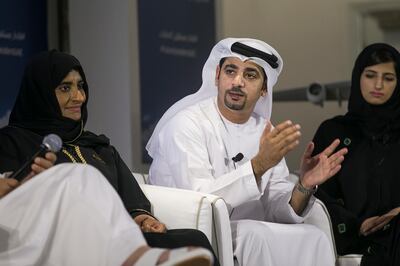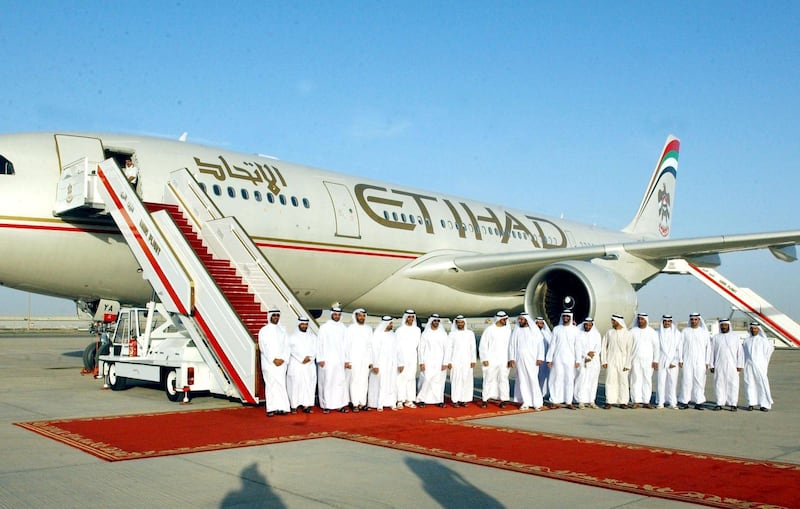Just after sunset on November 5, 2003, an air of expectation began to build at Abu Dhabi International Airport.
In a quiet part of the apron, people were arriving to witness the dawn of a new era in aviation.
“We were sitting in an area that looked like a temporary hold,” says Faisal Al Mulla, 39, now the head of human resources at Etihad Airways.
A long, black curtain hung at one end and there were chairs at the other. A countdown began, the curtain fell away and Etihad, the new flag carrier of the UAE was revealed.
“All the lights went on, we had music and there was a laser display. It was brilliant," he says.
At the time, Mr Al Mulla was working for the ARN radio network in Dubai and had been invited by Etihad to join its ceremonial inaugural flight to Al Ain that evening.
The Airbus A330-200 took off shortly after the ceremony for the 40-minute flight to the Garden City. Passengers were given boarding passes that read “inaugural flight”.
They flew over Al Wathba, Remah and the soft dunes of Yahar. To the right soared Jebel Hafeet as the lights of Al Ain glinted in the dark. "We could see all the street lights as we were getting closer," says Mr Al Mulla.
After landing, passengers disembarked to a welcome of traditional music and dancing. A cake with Etihad’s livery was also cut in celebration of the occasion.
That flight in 2003 marked the start of an incredible journey. In the 15 years since, the business has grown from operating two A330-200 aircraft on a single route to Beirut to its present-day fleet of 110 Boeing and Airbus aircraft, serving 91 destinations in 53 countries. There were just 150 staff at launch.

Today, Etihad Aviation Group employs more than 22,000 people.
The first few years of the 21st century were tough for the aviation industry, making it an especially challenging time to launch an airline. Global passenger numbers and confidence declined after the September 11 attacks in 2001.
Two airlines, Swissair and Sabena, went bust before the year was out. Worldwide airline revenues dipped by 7.5 per cent in 2002, according to International Air Transport Association data.
Sheikh Ahmed Al Nahyan, then chairman of Etihad, addressed these tough market conditions in an interview with Gulf News in November 2003: "Launching an airline when the travel industry as a whole is experiencing one of the most difficult periods in history may appear a very bold strategy, but we have done our homework."
Passengers were called “guests” and staff were dressed in uniforms created by Italian designer Ettore Bilotta, who also revamped the airline’s uniform in 2015.
By the following year, Etihad was flying 15 times a week to London, to India and the Far East.
As inaugural passengers boarded the return flight to Abu Dhabi, they were in for one more surprise. The pilot veered north and flew at a low-altitude over all the other emirates. First Fujairah, across to Ras Al Khaimah and then over Umm Al Quwain, Ajman, Sharjah and Dubai.
“As we were flying, the pilot was explaining where we were and what we were looking at,” says Mr Al Mulla. “It was amazing to see Sharjah at night from the sky.”
Passengers were each given a piece of crystal after the flight to mark the occasion. Pictures of famous Abu Dhabi landmarks such as the Volcano Fountain was inscribed inside.
Mr Al Mulla would join Etihad in 2011 and even he could not imagine the transformation since that first flight.
"To come here and remember that day, I really never thought I would be sitting here.”
The A330 that made the inaugural flight had capacity for around 250 “guests”. More than 18.5 million people flew with Etihad last year.
_______________
Read more:
Timeframe: swing on the wing of an Etihad plane
Exclusive: Inside the UAE factory where parts for the world's superjumbos are finely crafted






